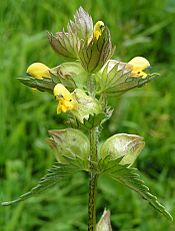Chaceley Meadow SSSI facts for kids
| Site of Special Scientific Interest | |

Close-up of yellow rattle (Rhinanthus minor)
|
|
| Area of Search | Gloucestershire |
|---|---|
| Coordinates | 51°58′27″N 2°12′32″W / 51.97413°N 2.20885°W |
| Interest | biological |
| Area | 1.8 ha (4.4 acres) |
| Notification | 1954 |
Chaceley Meadow is a special place in Gloucestershire, England. It's a Site of Special Scientific Interest (SSSI), which means it's protected because of its important plants and wildlife. This meadow covers about 1.8 hectares, which is roughly the size of two football fields.
It was first recognized as an SSSI in 1954. Chaceley Meadow is located near the village of Chaceley, not far from the River Severn. Even though it's a bit away from the river, the meadow can sometimes get flooded in winter, which helps create its unique wet environment.
The Gloucestershire Wildlife Trust owns and looks after this meadow. They bought it in 1994 to make sure its special nature is preserved. It's known as one of the best "unimproved wet meadows" in the county. This means it hasn't been changed much by farming or building, so it keeps its natural wild plants.
Discover the Meadow's Plants
Chaceley Meadow is a beautiful place to see many different wildflowers. They bloom throughout spring and summer, making the meadow very colourful.
Here are some of the flowers you might spot:
- Cuckoo flower
- Marsh-marigold
- Great burnet
- Meadowsweet
- Common knapweed
- Meadow vetchling
- Marsh ragwort
- Meadow buttercup
- Sorrel
- Ragged robin
- Yellow rattle
The wet ground in the meadow is perfect for many types of sedge plants. These are grass-like plants that love damp places. Some sedges found here include:
- Brown sedge
- Oval sedge
- Yellow sedge
- Carnation sedge
A very special plant called slender spike-rush (Eleocharis uniglumis) also grows in this meadow. It's quite rare to find it in Gloucestershire!
Wildlife Around the Meadow
The edges of Chaceley Meadow are lined with old hedges made of hawthorn and blackthorn trees. These hedges are like natural fences. There are also old white willow trees that have been pollarded. Pollarding is a way of cutting trees to encourage new growth higher up, which creates a unique shape.
These hedges and trees provide a great home for many different birds. You might hear or see:
Protecting Chaceley Meadow
The people who manage Chaceley Meadow use traditional methods to keep it healthy. This helps the wildflowers and other species thrive.
Here's how they take care of the meadow:
- Late Summer Hay Cut: Every year, the meadow grass is cut for hay in late summer. This is important because it allows the wildflowers to drop their seeds first. This way, new plants can grow the next year.
- Cattle Grazing: After the hay is cut, cattle are allowed to graze in the meadow. Their grazing helps to keep the grass from growing too tall and lets the smaller wildflowers get enough sunlight.
- Willow Tree Care: The old willow trees are regularly re-cut. This is done to prevent their branches from splitting off, which keeps the trees healthy and strong.
- Earlier Cuts for Rare Plants: Every three years, some parts of the meadow are cut earlier in the season. This special cut helps rarer plants grow better by removing extra nutrients from the soil. Some of the plants that benefit from this include common knapweed, yellow rattle, cuckoo flower, bird's foot trefoil, and marsh bedstraw.
These careful management practices ensure that Chaceley Meadow remains a wonderful home for its unique plants and animals for many years to come.

